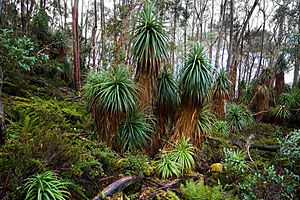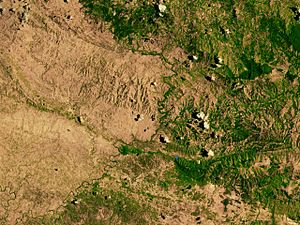Biosequestration facts for kids
Imagine our planet breathing! Just like we breathe out carbon dioxide, the Earth's natural systems can breathe it in and store it. This amazing process is called biological carbon sequestration (say: bye-oh-see-kwes-TRAY-shun). It means capturing and storing carbon dioxide (a greenhouse gas) from the air using living things.
This happens mostly through plants and soil. Plants use a process called photosynthesis to take in carbon dioxide. By taking care of our land, like planting more trees or managing forests wisely, we can help nature store a lot more carbon dioxide every year. This includes protecting and restoring important places like forests, peatlands, wetlands, and grasslands. Even farming methods can help store carbon in the soil!
Contents
What is Biological Carbon Sequestration?
Biological carbon sequestration is when nature helps clean the air. It's a way to remove carbon dioxide, a gas that traps heat in our atmosphere, using living things. This process helps to slow down climate change.
How Plants Help: Photosynthesis
Plants are like tiny carbon-capturing factories. They use sunlight, water, and carbon dioxide from the air to make their own food. This process is called photosynthesis. When plants grow, they store carbon in their leaves, stems, and roots.
- More plants mean more carbon dioxide is taken out of the air.
- This stored carbon helps the plant grow big and strong.
- When plants die, some of this carbon can go into the soil.
Forests: Nature's Carbon Sponges
Forests are super important for storing carbon. They are like giant carbon sponges!
- Reforestation: This means planting new trees in areas where forests have been cut down. New forests can absorb a lot of carbon as they grow.
- Sustainable Forest Management: This is about managing forests in a way that keeps them healthy and growing for a long time. It ensures trees continue to absorb carbon year after year.
- When forests are cut down (deforestation), the stored carbon can be released back into the air.
Healthy Soils, Healthy Planet
Soil is not just dirt; it's full of life and can store a lot of carbon!
- Soil Carbon Sequestration: This is when carbon is stored in the soil. It happens naturally when plants die and break down.
- Farming Methods: Farmers can use special methods to put more carbon into the soil. This includes things like:
- Planting cover crops (plants grown to protect the soil).
- Not tilling the soil too much (leaving it undisturbed).
- Adding compost or other organic materials.
- Healthy soil also helps plants grow better and holds more water.
Other Important Ecosystems
Besides forests and farmlands, other natural places are also great at storing carbon.
- Peatlands: These are wet, boggy areas where dead plants build up over thousands of years. They store huge amounts of carbon.
- Wetlands: Areas like marshes and swamps also store carbon in their plants and soil.
- Grasslands: These open, grassy areas store a lot of carbon in their deep root systems and the soil.
- Protecting these ecosystems is just as important as planting new trees.
Images for kids





